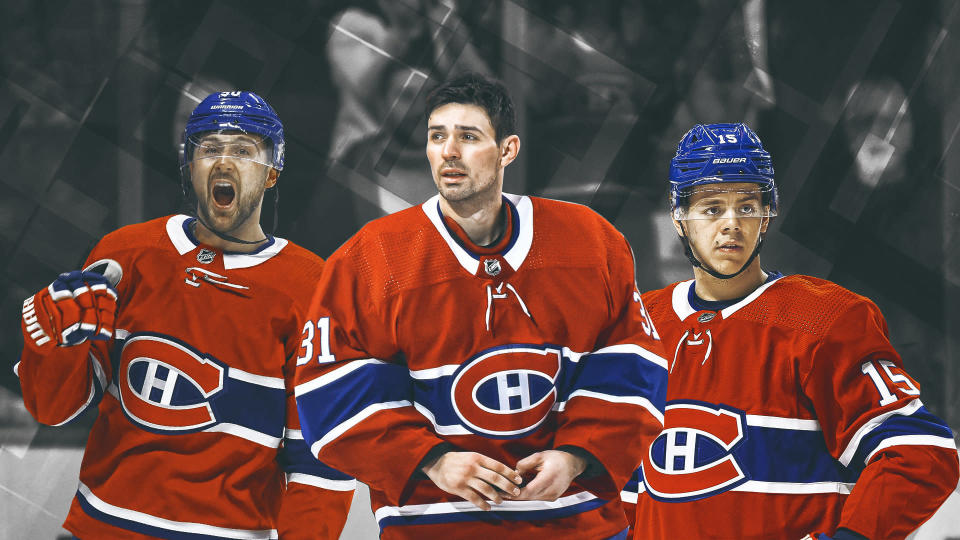How the Canadiens wound up just short of improbable playoff berth

Putting 96 on the board this season, the Montreal Canadiens matched the NHL’s record for the most points counted by a team that failed to qualify for the Stanley Cup playoffs.
Failing on a bell curve has been, which goes without saying, immensely disappointing for everyone involved, but a reminder of the projections, expectations and bleakness to the franchise’s outlook at the season’s outset will paint a far different picture when reflecting on the 2018-19 Habs.
Jobs were saved and reputations restored following a run of successful transactions and a return to a playing style that better serves the personnel at Claude Julien’s disposal.
Still, a certain level of over-achievement will define this season for Montreal, and significant improvements will have to be made for the Canadiens to leave no doubt next season inside the top-heavy Atlantic Division.
For now we’ll look back on what went right, and what had the Canadiens miss by the slightest of margins.
Bergevin’s rescue
What were the reasonable expectations for a team that bookended its summer with trades involving its top two most productive players over the last half decade? Marc Bergevin’s decision to send Alex Galchenyuk and Max Pacioretty to separate locations dotting the NHL’s southwest expansion was supposed to set the franchise back. Instead, it reinvigorated it.
Max Domi led that charge, enjoying the best individual season among players involved in those two landmark deals. He more than tripled his goal output from his final season in Arizona while improving his career-high point total by 25. On top of that, Domi fulfilled the vacant centre-ice spot that Galchenyuk couldn’t (surprising many pundits and skeptics alike) to provide Montreal with a formidable one-two punch down the middle with Philip Danault.
While not the jewel (more like just a live body) in the Pacioretty deal, Tomas Tatar certainly helped soothe the loss by out-producing the former captain, who was essentially a lock for 30 goals up until the final season of his Montreal tenure. Tatar was the finishing element to Montreal’s No. 1 unit with Danault and Brendan Gallagher, which flourished down the stretch.
With 53 goals and 130 points combined between Domi and Tatar, the Canadiens netted out plus 12 goals and 49 points from the two deals and added a second top centre prospect to the system in Nick Suzuki to eventually pair through the middle with No. 3 overall selection Jesperi Kotkaniemi.
Smaller deals, such as poaching Joel Armia from the Winnipeg Jets and adding defenseman Brett Kulak in a deal with Calgary further bolstered Bergevin’s important and impressive summer.
New influences
Even with unexpected plus production from Domi and Tatar, the Canadiens had to overcome a talent discrepancy to come within a hair of a postseason spot. They achieved that through the commitment to a structure that catered to the talent on the roster as organized, in part, by two additions to the coaching staff.
The influence of Dominique Ducharme and Luke Richardson is hard to quantify or pinpoint precisely, but the presence of the new assistants was certainly no small thing for head coach Claude Julien and the Habs. With Ducharme working with Kirk Muller and the forwards and Richardson organizing the back end, each deserve credit for unlocking Montreal’s speed and chaining together efficiencies through all three zones to help the Canadiens finish the season as one of four teams with over 54 percent shot share at even strength and a top-tier expected goal share.
That Domi, Tatar, Danault and a fleet-footed puck mover like Jeff Petry had career-best seasons is probably no coincidence given the marked change to Montreal’s style.
Ugliness with a man up
What Montreal could neutralize through systems and speed couldn’t be masked with the man advantage. If there’s one thing to point to as the reason for Montreal’s fractional failure, it’s the Canadiens’ misery on the power play.
Montreal’s 31 goals with the man advantage was just one better than the most fruitless power play over the last five seasons, which belongs to the 2014-15 Buffalo Sabres and 2016-17 Colorado Avalanche — teams that finished the season with 54 and 48 points, respectively.
Julien, Muller and Ducharme have to wear some of this failure, but much of it comes down to the tools available. With Jonathan Drouin so far failing to be the difference creatively, Montreal’s plus skills and functions on the attacking side of special teams might be limited to the heaviness of Shea Weber’s shot and Brendan Gallagher’s work down low. It’s been proven now that it’s not enough to build even an average special teams unit around.
Right Price
Folks that predicted Carey Price’s decline to begin simultaneous to his max extension kicking in seemed validated when the Habs goaltender struggled through the first few weeks of the season and improved to be only merely average leading into the holiday break.
Price was brilliant, however, throughout the second half, emerging as the single most important force in Montreal’s drive toward the eighth seed. He’s proved that he can, for now, live up to the expectations attached to a $10.5 million goaltender salary.
More NHL coverage on Yahoo Sports

 Yahoo Sports
Yahoo Sports 

